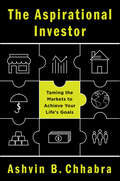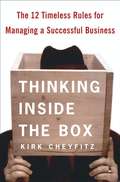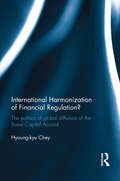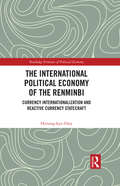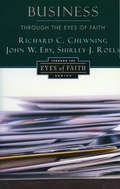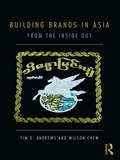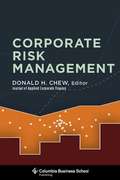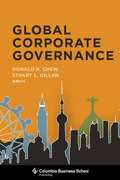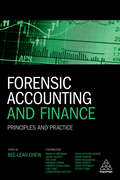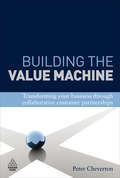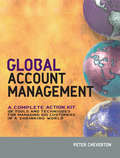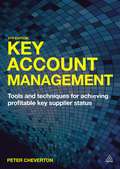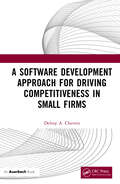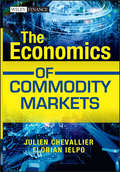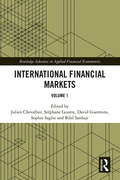- Table View
- List View
The Aspirational Investor: Taming the Markets to Achieve Your Life's Goals
by Ashvin B. ChhabraThe Chief Investment Officer of Merrill Lynch Wealth Management explains why goals, not markets, should be the primary focus of your investment strategy—and offers a practical, innovative framework for making smarter choices about aligning your goals to your investment strategy.Today all of us bear the burden of investing wisely, but too many of us are preoccupied with the wrong priorities—increasing returns at all costs, finding the next star fund manager, or beating “the market.” Unfortunately conventional portfolio theory and the grand debates in finance have offered investors only incomplete solutions. What is needed, argues Ashvin B. Chhabra, is a framework that shifts the focus of investment strategy from portfolios and markets to individuals and the objectives that really matter: things like protecting against unexpected financial crises, paying for education or retirement, and financing philanthropy and entrepreneurship.The Aspirational Investor is a practical, innovative approach to managing wealth based on key goals and the careful allocation of risks rather than responding to the whims of the financial markets. Chhabra introduces his “Wealth Allocation Framework,” which accommodates the three seemingly incompatible objectives that must underpin every sound wealth management plan: the need for financial security in the face of known and unknowable risks; the need to maintain current living standards over time despite inflation; and the need to pursue aspirational goals for wealth creation.Chhabra reveals some surprising facts about wealth creation, reinterprets the success formulas of investing greats like Warren Buffett, and closes the gap between theory and practice by simplifying our understanding of key asset classes and laying out a concise roadmap for identifying, prioritizing, and quantifying financial goals. Raising the bar for what we should expect from our investment portfolios—and our financial advisors—The Aspirational Investor sets us on a path to more confident and fulfilling financial lives.
Thinking Inside the Box: The 12 Timeless Rules for Managing a Successful Business
by Kirk CheyfitzFor the past decade and more, everyone in business was told that success in a rapidly changing world required constant "thinking outside the box." The result has often been financially and ethically disastrous. Now, in a radical reassessment of what really works, this book shows that the business world lost its way when it forgot how to think inside the box. Challenging the prevailing wisdom and trend-of-the-minute management advice, award-winning journalist and international businessman Kirk Cheyfitz lays out a set of historically proven principles he calls "The Box" -- the 12 unchanging rules for building, expanding, and maintaining a strong business. Everyone with an interest in business -- whether students, entrepreneurs, corporate managers, consultants, or CEOs -- will benefit from the brilliant and fundamental insights of Thinking Inside The Box: Learn to tell the difference between what can and cannot be controlled by management, and focus on the areas that will make the most difference. Understand the economic principles that never change so you can devote your attention to the things that are changing all the time. Rediscover the critical discipline of planning for profit. Understand why some acquisitions work and most don't. And much more...The book draws on in-depth research, Cheyfitz's long personal experience as an entrepreneur and corporate manager, and revealing interviews with business leaders such as Microsoft CEO Steve Ballmer and Prudential Securities CEO John Strangfeld. Combining these elements, Cheyfitz presents a compelling, reliable, and well-documented account of successful business practices that have met the challenges of the ages. With a practical approach and carefully documented examples, Cheyfitz mercilessly exposes the hype and inaccuracies of so-called business gurus preaching the need for constant "revolution" in business.From its very first words -- a preface titled "Don't Do Anything Stupid" -- to its very last, Thinking Inside The Box demonstrates that the only way to think outside the box productively is to learn each plank in The Box and practice it daily. For the first time, a book explains what the dot-com crash, the telecom disaster, the Enron collapse, and all the myriad, multibillion-dollar business catastrophes of the last decade have in common -- a total lack of regard for (or complete ignorance of) the basic rules of business. Here, finally, is the indispensable book that shows managers and investors where to find the path to enduring success again.
International Harmonization of Financial Regulation?: The Politics of Global Diffusion of the Basel Capital Accord
by Hyoung-kyu CheyIt is often argued that international financial regulation has been substantially strengthened over the past decades through the international harmonization of financial regulation. There are, however, still frequent outbreaks of painful financial crises, including the recent 2008 global financial crisis. This raises doubts about the conventional claims of the strengthening of international financial regulation. This book provides an in-depth political economy study of the adoptions in Japan, Korea and Taiwan of the 1988 Basel Capital Accord, the now so-called Basel I, which has been at the center of international banking regulation over the past three decades, highlighting the domestic politics surrounding it. The book illustrates that, despite banks’ formal compliance with the Accord in these countries, their compliance was often cosmetic due to extensive regulatory forbearance that allowed their real capital soundness to weaken. Domestic politics thus ultimately determined national implementations of the Accord. This book provides its novel innovative study of the Accord through scores of interviews with bank regulators and analysis of various primary documents. It suggests that the actual effectiveness of international financial regulation relies ultimately on the domestic politics surrounding it. It implies as well that the past trend of international harmonization of financial regulation may be illusory, to at least some extent, in terms of its actual effectiveness. This book may interest not only political economists but also scholars working on the intersection of law, economics and institutions.
The International Political Economy of the Renminbi: Currency Internationalization and Reactive Currency Statecraft (Routledge Frontiers of Political Economy)
by Hyoung-kyu CheyAlthough the internationalization of the Chinese renminbi is an important international political event, most of the studies of it place their analytical focuses largely just on China itself, the issuer of the currency. In contrast, this book addresses the question of how foreign states have responded to the renminbi’s internationalization, during its initial phase through the 2010s, and thereby breaks new ground in exploring the international politics of currency internationalization. It builds a theoretical framework for analyzing a state’s policy toward renminbi internationalization, developing the key concept of reactive currency statecraft. It then applies this framework to the four select cases of the United Kingdom, Japan, South Korea and the United States. This book reveals that all four of these countries have deliberately utilized their policies related to renminbi internationalization as means of achieving their own foreign policy goals associated with China, goals that have been principally economic in some cases but political in others. Remarkably, the predominant mode of response to the renminbi’s internationalization has been accommodative. Even the United States and Japan—China’s chief geopolitical and also international currency rivals—have never attempted to actively suppress it. This study provides new insights to anyone concerned with the transformation of the world monetary order, while also contributing a valuable analysis of the international politics surrounding the rise of China.
Business Through the Eyes of Faith
by Richard C. Chewning John W. Eby Shirley J. RoelsIs capitalism Christian? Is there a Christian perspective on business? How should a Christian use power in the workplace? In addressing such difficult questions as these, Business Through the Eyes of Faith demonstrates how God can dwell at the center of one's life even in the secular marketplace. Here is pragmatic affirmation of the role that committed Christians can play in the business world. The authors stress the connections between Christian principles and good management and provide biblical passages that support their principles and relate them to the practical issues faced by Christian managers. Issues such as employee motivation, workplace communication, business leadership, the role of profit, and social responsibility are all addressed in concrete terms and reinforced by short vignettes, suggested biblical passages to explore, and commentaries from contemporary theorists and practitioners. Business Through the Eyes of Faith shows that business can and should be a reflection of God's kingdom. It is an invaluable resource for Christian business students, managers, and those who wish to understand the concerns and motives of Christians in the business world.
Building Brands in Asia: From the Inside Out
by Wilson Chew Tim AndrewsIn a global business environment characterized by volatility and change, the formation of enduring relationships with consumers is paramount, but also notoriously difficult. Developing a unique brand personality is increasingly recognized as a key method to achieving the goal of customer loyalty. Focusing on the creation, development and management of brands in the world’s most dynamic, diverse and challenging business environment, Building Brands in Asia challenges the assumption that the continuing success of global brands in Asia is a given. The first part examines the challenge multinational corporations face in balancing brand consistency with local effectiveness. In the second part, attention shifts to Asian company brands, where the focus on branding has been relatively muted until now. Through a variety of sector and country contexts – from facilities management to football clubs, places to pop bands, home appliances to home weaving - we narrate simply and clearly the value, meaning, auditing, aligning, extending and architecture of brands from the likes of Haier, Ah Yee Taung, Axis Bank, OCS, Caltex, Manchester United and Thai Airways in markets as diverse as Japan, Laos, Korea and Singapore. Replete with anecdotes, interviews and case studies, Andrews and Chew provide an insightful, detailed and timely examination for all those interested in today’s primary corporate preoccupation set in the world’s most exciting marketplace.
Control Tomorrow's Costs Through Today's Designs
by W. Bruce Chew Robin CooperIn the past, companies took a cost-plus approach to pricing, charging high prices when a product was first released, then lowering prices when production was scaled up. Lean competitors make that approach impossible, however, as they are quick to introduce competitive "me too" products to market. To gain and hold market leadership today, a company must design the cost out of its products from the outset. Target costing is a cost-management technique that lets a company do just that: The company determines how much customers are willing to pay for a product and then designs the product within cost limits that will permit it to sell profitably at the predetermined price.
Glossary of TOM Terms
by W. Bruce ChewProvides definitions of technology and operations management terms.
Corporate Risk Management: Strategies Management (Columbia Business School Publishing Ser.)
by Chew Donald H. Ed.More than thirty leading scholars and finance practitioners discuss the theory and practice of using enterprise-risk management (ERM) to increase corporate values. ERM is the corporate-wide effort to manage the right-hand side of the balance sheet-a firm's total liability structure-in ways that enable management to make the most of the firm's assets. While typically working to stabilize cash flows, the primary aim of a well-designed risk management program is not to smooth corporate earnings, but to limit the possibility that surprise outcomes can threaten a company's ability to fund its major investments and carry out its strategic plan. Contributors summarize the development and use of risk management products and their practical applications. Case studies involve Merck, British Petroleum, the American airline industry, and United Grain Growers, and the conclusion addresses a variety of topics that include the pricing and use of certain derivative securities, hybrid debt, and catastrophe bonds.Contributors: Tom Aabo (Aarhus School of Business); Albéric Braas and Charles N. Bralver (Oliver, Wyman & Company); Keith C. Brown (University of Texas at Austin); David A. Carter (Oklahoma State University); Christopher L. Culp (University of Chicago); Neil A. Doherty (University of Pennsylvania); John R. S. Fraser (Hyrdo One, Inc.); Kenneth R. French (University of Chicago); Gerald D. Gay (Georgia State University); Jeremy Gold (Jeremy Gold Pensions); Scott E. Harrington (University of South Carolina); J. B. Heaton (Bartlit Beck Herman Palenchar & Scott LLP); Joel Houston (University of Florida); Nick Hudson (Stern Stewart & Co.); Christopher James (University of Florida); A. John Kearney and Judy C. Lewent (Merck & Co., Inc.); Robert C. Merton and Lisa K. Meulbroek (Harvard Business School); Merton H. Miller (University of Chicago); Jouahn Nam (Pace University); Andrea M. P. Neves (CP Risk Management LLC); Brian W. Nocco (Nationwide Insurance); André F. Perold (Harvard Business School); S. Waite Rawls III (Continental Bank); Kenneth J. Risko (Willis Risk Solutions); Angelika Schöchlin (University of St. Gallen); Betty J. Simkins (Oklahoma State University); Donald J. Smith (Boston University); Clifford W. Smith Jr. (University of Rochester); Charles W. Smithson (Continental Bank); René M. Stulz (Ohio State University); D. SAll the articles that comprise this book were first published in the Journal of Applied Corporate Finance. Morgan Stanley's ownership of the journal is a reflection of its commitment to identifying outstanding academic research and promoting its application in the practicing corporate and investment communities.
Corporate Risk Management
by Chew Donald H.More than 30 leading scholars and finance practitioners discuss the theory and practice of using enterprise-risk management (ERM) to increase corporate values. ERM is the corporate-wide effort to manage the right-hand side of the balance sheet& mdash;a firm's total liability structure-in ways that enable management to make the most of the firm's assets. While typically working to stabilize cash flows, the primary aim of a well-designed risk management program is not to smooth corporate earnings, but to limit the possibility that surprise outcomes can threaten a company's ability to fund its major investments and carry out its strategic plan. Contributors summarize the development and use of risk management products and their practical applications. Case studies involve Merck, British Petroleum, the American airline industry, and United Grain Growers, and the conclusion addresses a variety of topics that include the pricing and use of certain derivative securities, hybrid debt, and catastrophe bonds. Contributors: Tom Aabo (Aarhus School of Business); Albéric Braas and Charles N. Bralver (Oliver, Wyman & Company); Keith C. Brown (University of Texas at Austin); David A. Carter (Oklahoma State University); Christopher L. Culp (University of Chicago); Neil A. Doherty (University of Pennsylvania); John R. S. Fraser (Hyrdo One, Inc.); Kenneth R. French (University of Chicago); Gerald D. Gay (Georgia State University); Jeremy Gold (Jeremy Gold Pensions); Scott E. Harrington (University of South Carolina); J. B. Heaton (Bartlit Beck Herman Palenchar & Scott LLP); Joel Houston (University of Florida); Nick Hudson (Stern Stewart & Co.); Christopher James (University of Florida); A. John Kearney and Judy C. Lewent (Merck & Co., Inc.); Robert C. Merton and Lisa K. Meulbroek (Harvard Business School); Merton H. Miller (University of Chicago); Jouahn Nam (Pace University); Andrea M. P. Neves (CP Risk Management LLC); Brian W. Nocco (Nationwide Insurance); André F. Perold (Harvard Business School); S. Waite Rawls III (Continental Bank); Kenneth J. Risko (Willis Risk Solutions); Angelika Schöchlin (University of St. Gallen); Betty J. Simkins (Oklahoma State University); Donald J. Smith (Boston University); Clifford W. Smith Jr. (University of Rochester); Charles W. Smithson (Continental Bank); René M. Stulz (Ohio State University); D. S All the articles that comprise this book were first published in the Journal of Applied Corporate Finance. Morgan Stanley's ownership of the journal is a reflection of its commitment to identifying outstanding academic research and promoting its application in the practicing corporate and investment communities.
Kinder Morgan, Inc.--Management Buyout
by Francine Chew Leslie S. Pierson Nabil N. El-Hage Ewa BierbrauerKinder Morgan, Inc., was a leader in the transportation and distribution of energy throughout North America, managing a master limited partnership with over $35 billion in infrastructure assets. In the summer of 2006, Richard Kinder, the founder and Chairman of Kinder Morgan, led a consortium of buyers to take the company private. The independent board of directors of Kinder Morgan must decide whether or not to accept Kinder's offer and assess the fairness of the proposal, given the conflicts of interest in this management buyout.
Global Corporate Governance (Columbia Business School Publishing Ser.)
by Donald H. Chew Stuart L Gillan Eds.Effective corporate governance, or the set of controls and incentives that drive top management, originates both outside and inside the firm and assures investors who hope to commit their capital. Essential when buying stocks in one's own country, effective corporate governance is even more important abroad, where information can be less reliable and investor influence (or protection) more limited. In this collection of articles from the Journal of Applied Corporate Finance, more than thirty leading scholars and practitioners discuss the possibilities and limitations of global corporate finance and governance systems, whether in Europe and North America or in the emerging markets of Israel, India, Korea, and South Africa. Essays discuss the political roots of American corporate finance; the structural and financial variations between international corporations; control premiums and the effectiveness of corporate governance systems; debt, folklore, and cross-country differences in financial structures; the driving forces behind the East Asian Financial Crisis of 1997; corporate ownership and control in India, Germany, France, and the United Kingdom; financial and economic lessons of Italy's privatization program; changes in Korean corporate governance; sovereign wealth funds; and the new organization of Canadian business trusts. A special roundtable discussion addresses shareholder activism in the U.K.
Strategic Positioning in Voluntary and Charitable Organizations (Routledge Studies in the Management of Voluntary and Non-Profit Organizations)
by Celine ChewRekindling the critical analysis of the adoption of generic commercial (for-profit) management approaches in the non-profit context, Strategic Positioning in Voluntary and Charitable Organizations reveals that charities are positioning themselves in their evolving external environment in distinctive ways that are not adequately explained by existing positioning theories. Based on original research that examines, for the first time, the usefulness of contemporary theoretical perspectives and interpretations of strategic positioning derived from the existing literature in explaining the positioning activities of charitable organizations within the wider voluntary and non-profit sector. Using a three-stage approach, which involves an exploratory survey and multiple case studies, this book provides: • evidence showing the extent of strategic positioning, the components of a positioning strategy and the process of developing a positioning strategy in charitable organizations that are involved in the provision of public services, • analysis of the key factors that influence the choice of a positioning strategy in the charitable context, and the depiction of these factors in an original integrating model, and • an exploration into the extent to which existing strategy/marketing literature on positioning is applicable in the charitable context. By challenging the adoption of current perspectives on strategic positioning derived from commercial strategy and marketing management literatures into the non-profit and non-market contexts, the author develops a theoretical framework that accounts for the uniqueness of positioning strategy in the non-profit sector. This uniqueness is attributed to the difference in positioning goals, the process of developing a positioning strategy, and the influencing factors on the choice of a positioning strategy in charities compared to commercial organizations. The implications of the findings provide useful lessons for managers of voluntary and charitable organizations in planning and developing their positioning activities, and for other stakeholders, such as policy makers, funders, donors and industry bodies.
Forensic Accounting and Finance: Principles and Practice
by Bee-Lean ChewA complete guide to Forensic Accounting and Finance, this book is ideal for advanced-level students and new or mid-level forensic accounting professionals looking to boost their specialist knowledge as part of their CPD, for accountants who wish to build more knowledge in this skills area or advanced undergraduates who feel ready to stretch themselves. Demand for expertise in this field is growing, and Forensic Accounting and Finance offers a complete, accessible and affordable guide, combining coverage of principle theory with the real and practical needs of the professional. Written by a strong academic and practitioner author team and in association with the Network for Independent Forensic Accountants, this book covers all forensic accounting topics from forensics as an extension of auditing and the basic principles of forensic accounting, to financial analysis and modelling, financial reporting, financial crime, and IT systems. Forensic Accounting and Finance shares current examples and case studies, highlighting cultural differences for key topics with updated regional legislation information available online for those looking for a truly global approach which is always up to date.
The Pilgrim’s Guide to the Workplace (SpringerBriefs in Business)
by Agustin ChevezThis is an Open Access book.Hoping to incubate a unique idea about workplace design, Dr. Agustin Chevez walked in isolation for 42 days from Melbourne to Sydney. His pilgrimage delivered 34 Signposts, a collection of insights which hold the promise to guide us to a better place to work. While firmly positioned within the shifting context of work, the Signposts point away from reactive solutions with a short shelf life. Instead, these markers are infused with a diversity of thought instilled by Agustin’s pilgrimage and reclaim the forgotten qualities of solitude, boredom, adversity, and absurdity as mechanisms to deliver innovation and create improved working environments. On his way to Sydney Agustin relied on maps and people with local knowledge of the lands he traversed. Similarly, in this book, he consults people with local knowledge in various design disciplines, management, and technology as he navigates the many regions of the workplace and work practices covered by the Signposts. When he reaches the end of the known trails, he starts laying paths that take us closer to where the Signposts converge. Agustin writes from the perspective of a pilgrim, architect, workplace consultant, and researcher and invites you to join him as a fellow pilgrim. You will be rewarded with a journey that revisits our assumptions about the way we use space to host the ever-evolving notion of work – an expedition leading not only to better versions of the workplace, but a better version of ourselves. “This book takes about three hours to read, and it could take a lifetime to fully extract all the benefits that it contains. This does not suggest that there are not immediate benefits available from reflecting on and applying the Signposts that are core to the book's intellectual contribution.” - Peer Review extract
Building the Value Machine
by Peter Cheverton Kingsley WeberBuilding the Value Machine represents the type of business that many aspire towards - a business able to align its internal functions (sales, marketing etc) in order to collaborate with its key customers in the creation of real and unique value for mutual benefit. The challenge is to find the right organizational structures, the right planning and operational processes, and to place all of that under the right kind of leadership in order to create the 'right kind of value' - the kind that will be good for the customer's business, and the kind that will be good for our own. The business that pursues these goals is the sort of business explored in this book - the business that wishes to become a true Value Machine. Building the Value Machine shows you how to target your customers effectively, match the capabilities of the business with the needs of the customer and align all the business functions through successful leadership. The result is a business that is truly aligned with its customers, and fully attuned to the vital match between their own functional requirements (knowing which opportunities to chase) and the customer requirements (being able to deliver the value required). It is a business that knows how to learn, developing both its processes and its value propositions.
Global Account Management: a complete Action Kit of Tools and Techniques for Managing Key global Customers
by Peter ChevertonGlobal Account Management explains the significant challenges of establishing a global account strategy and guides you through the process of decisions and actions required to manage global accounts successfully. The book provides a thorough, workmanlike template for all businesses with global clients. It shows you the issues you need to consider from the point of view of both your customers and your company's internal structure.Author Peter Cheverton - an expert practitioner and teacher of account management - highlights the difference between an international company operating in different markets and one that can be considered as truly global. He reveals that, to operate accounts globally, you need to understand whether your client has consistent needs across different countries; possesses a global operational structure; and has the ability to implement global decisions. He then details the factors critical to your successful handling of a global account.The implications of making the wrong decisions in a global marketplace are enormous - Global Account Management gives you the information and insight you need to establish the best long-term relationships with your biggest clients, and - most importantly of all - secure the future success of your company. Global Account Management is an essential guide for business directors, sales and marketing directors, and global account managers.
Key Account Management
by Peter ChevertonAn organization's key accounts are its lifeblood. Key account management focuses on the long-term investment of resources in customers that can offer an exceptional return on resources. But which are the key accounts? Are they the ones growing the fastest? The ones that are most financially secure? Or are they the ones that shout the loudest? Key Account Management puts forward a straightforward and effective planning methodology. This fully updated sixth edition of Key Account Management takes a long-term, team-selling strategic view of the whole process, from defining the customer, to managing the relationship and achieving key supplier status. With coverage of latest best practice including IT's role in account management, plus new case studies, online supporting resources and a new section comparing how different industries/markets approach key account management, it stands alone as the premier book on managing key customers.
A Software Development Approach for Driving Competitiveness in Small Firms
by Delroy CheversThe COVID-19 Pandemic has forced many businesses to accelerate their digital transformation strategies to continue to meet the changing needs of their customers. This has resulted in significant growth in the global software market. However, for decades, managing software product quality has been a major challenge for many software development firms. This low success rate is due mainly to the development and delivery of low-quality software products. In addition to the direct costs associated with poor-quality software, software flaws can also raisesecurity concerns, as hackers can gain complete control of various devices and data, such as mobile phones, computers, or the operational transactions of businesses. These security and privacy breaches are currently occurring with great frequency. Although producers and consumers of software products spend vast amounts of money developing and purchasing these products, in many cases the promised benefits of user satisfaction, efficiency, productivity and profitability are not realized. In more severe circumstances, software development firms have failed and face the threat of going bankrupt, being acquired or suffering closure, because customers are demanding high-quality software products that they consistently fail to deliver. Small and medium enterprises (SMEs) operating within the software development industry have a more critical need to produce high-quality software since they are less able to absorb both the cost and the reputational impact of producing low-quality output. A Software Development Approach for Driving Competitiveness in Small Firms provides some cost-efficient options that can help SMEs increase the likelihood that their software will be of high quality. It tells the story of the entrepreneurial journey that small firms should take to deliver high-quality software products. By utilizing practical examples and providing several recommended solutions to decrease the likelihood of producing low-quality software, the book outlines how mobilizing people, processes and technology are integral to the software development process and emphasizes why process maturity is the most influential factor in software development in small and medium enterprises.
The Economics of Commodity Markets
by Julien Chevallier Florian IelpoAs commodity markets have continued their expansion an extensive and complex financial industry has developed to service them. This industry includes hundreds of participating firms, including asset managers, brokers, consultants, verification agencies and a myriad of other institutions. Universities and other training institutions have responded to this rapid expansion of commodity markets as well as their substantial future growth potential by launching specialized courses on the subject. The Economics of Commodity Markets attempts to bridge the gap between academics and working professionals by way of a textbook that is both theoretically informative and practical. Based in part on the authors' teaching experience of commodity finance at the University Paris Dauphine, the book covers all important commodity markets topics and includes coverage of recent topics such as financial applications and intuitive economic reasoning. The book is composed of three parts that cover: commodity market dynamics, commodities and the business cycle, and commodities and fundamental value. The key original approach to the subject matter lies in a shift away from the descriptive to the econometric analysis of commodity markets. Information on market trends of commodities is presented in the first part, with a strong emphasis on the quantitative treatment of that information in the remaining two parts of the book. Readers are provided with a clear and succinct exposition of up-to-date financial economic and econometric methods as these apply to commodity markets. In addition a number of useful empirical applications are introduced and discussed. This book is a self-contained offering, discussing all key methods and insights without descending into superfluous technicalities. All explanations are structured in an accessible manner, permitting any reader with a basic understanding of mathematics and finance to work their way through all parts of the book without having to resort to external sources.
Financial Mathematics, Volatility and Covariance Modelling: Volume 2 (Routledge Advances in Applied Financial Econometrics)
by Julien Chevallier Stéphane Goutte David Guerreiro Sophie Saglio Bilel SanhajiThis book provides an up-to-date series of advanced chapters on applied financial econometric techniques pertaining the various fields of commodities finance, mathematics & stochastics, international macroeconomics and financial econometrics. Financial Mathematics, Volatility and Covariance Modelling: Volume 2 provides a key repository on the current state of knowledge, the latest debates and recent literature on financial mathematics, volatility and covariance modelling. The first section is devoted to mathematical finance, stochastic modelling and control optimization. Chapters explore the recent financial crisis, the increase of uncertainty and volatility, and propose an alternative approach to deal with these issues. The second section covers financial volatility and covariance modelling and explores proposals for dealing with recent developments in financial econometrics This book will be useful to students and researchers in applied econometrics; academics and students seeking convenient access to an unfamiliar area. It will also be of great interest established researchers seeking a single repository on the current state of knowledge, current debates and relevant literature.
International Financial Markets: Volume 1 (Routledge Advances in Applied Financial Econometrics)
by Julien Chevallier Stéphane Goutte David Guerreiro Sophie Saglio Bilel SanhajiThis book provides an up-to-date series of advanced chapters on applied financial econometric techniques pertaining the various fields of commodities finance, mathematics & stochastics, international macroeconomics and financial econometrics. International Financial Markets: Volume I provides a key repository on the current state of knowledge, the latest debates and recent literature on international financial markets. Against the background of the "financialization of commodities" since the 2008 sub-primes crisis, section one contains recent contributions on commodity and financial markets, pushing the frontiers of applied econometrics techniques. The second section is devoted to exchange rate and current account dynamics in an environment characterized by large global imbalances. Part three examines the latest research in the field of meta-analysis in economics and finance. This book will be useful to students and researchers in applied econometrics; academics and students seeking convenient access to an unfamiliar area. It will also be of great interest established researchers seeking a single repository on the current state of knowledge, current debates and relevant literature.
Econometric Analysis of Carbon Markets: The European Union Emissions Trading Scheme and the Clean Development Mechanism
by Julien ChevallierThrough analysis of the European Union Emissions Trading Scheme (EU ETS) and the Clean Development Mechanism (CDM), this book demonstrates how to use a variety of econometric techniques to analyze the evolving and expanding carbon markets sphere, techniques that can be extrapolated to the worldwide marketplace. It features stylized facts about carbon markets from an economics perspective, as well as covering key aspects of pricing strategies, risk and portfolio management.
Charity Law: International Perspectives
by Juliet Chevalier-WattsThis work provides an analytical and comparative analysis of the development of charity law, as well as providing a critical commentary on a number of contemporary changes within the charity law field across a range of common law jurisdictions. The book follows earlier studies which cover a similar, and traditional, jurisdictional spread, but which are now dated. It further considers in detail charity law issues within Hong Kong and Singapore, about which there has been historically more limited charity law discussion. The area is growing in terms of practical legal and academic interest.
Luxury Brand Management
by Michel Chevalier Gérald MazzalovoThe definitive guide to managing a luxury brand, newly revised and updated What defines a luxury brand? Traditional wisdom suggests that it's one that's selective and exclusive-to such a degree that only one brand can exist within each retail category (automobiles, fragrances, cosmetics, etc. ). But this definition is inherently restrictive, failing to take into account the way in which luxury brands today are increasingly identified as such by their placement in stores and how consumers perceive them. This revised and updated edition of Luxury Brand Management, the first comprehensive book on luxury brand management, looks at the world of branding today. Written by two renowned insiders, the book builds on this new, broader definition of luxury and examines more than 450 internationally known brands from a wide range of industries. Packed with new information covering the financial crisis's impact on luxury brands, and looking towards a new period of growth, the book reconciles management, marketing, and creation with real-life examples and management tools that the authors have successfully used in their professional careers. Includes dedicated chapters focusing on each of the main functions of a luxury brand, including brand creation, the complexity of managing brand identity, the convergence of arts and brands, and much more Addresses the practical functions that can make or break bottom lines and affect brand perception, such as distribution, retailing, logistics, and licensing Focuses on brand life-cycle, brand identity, and licensing issues A compelling and comprehensive examination of the different dimensions of luxury management in various sectors, this new edition of the classic text on brand management is essential reading for anyone working with or interested in making the most of a luxury brand in the post-recession world.
